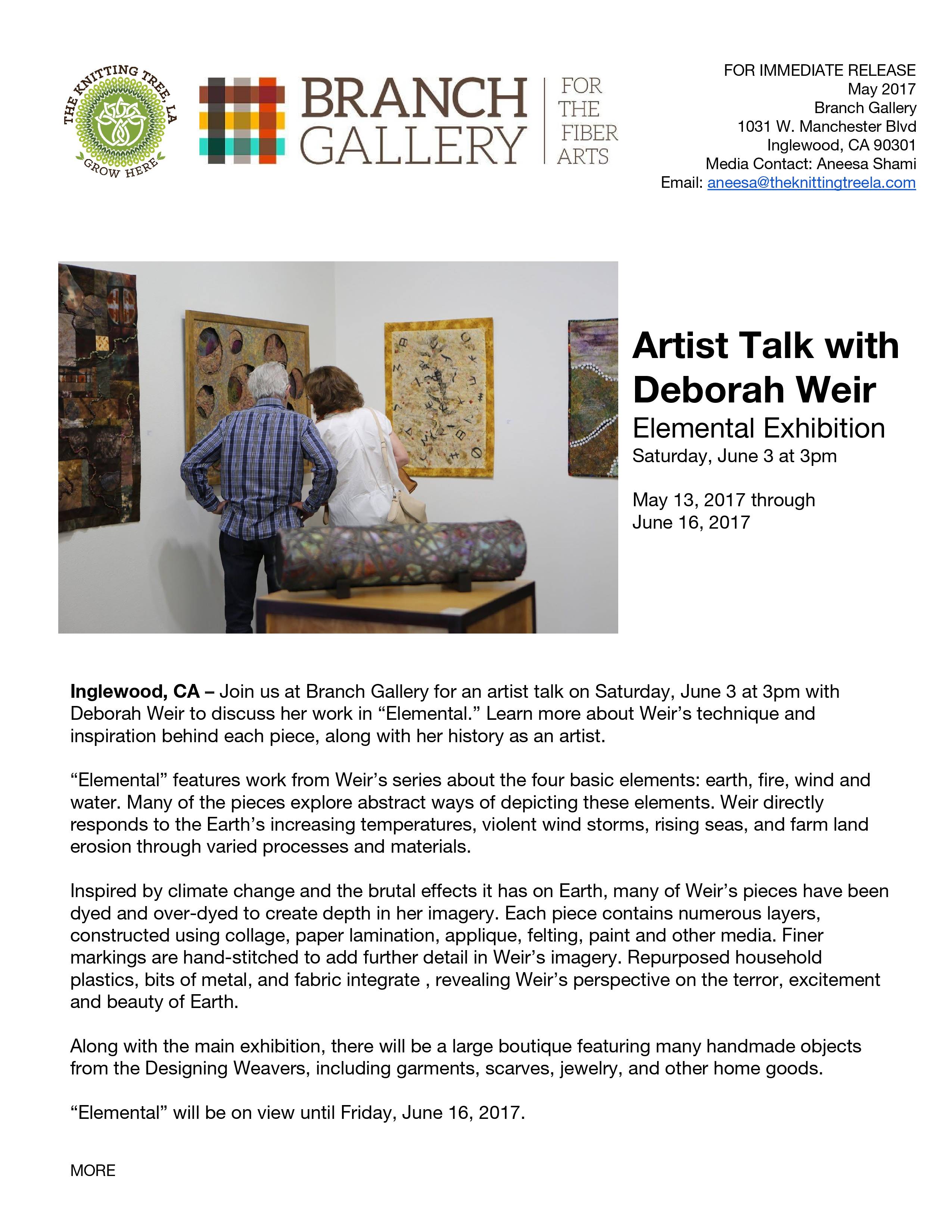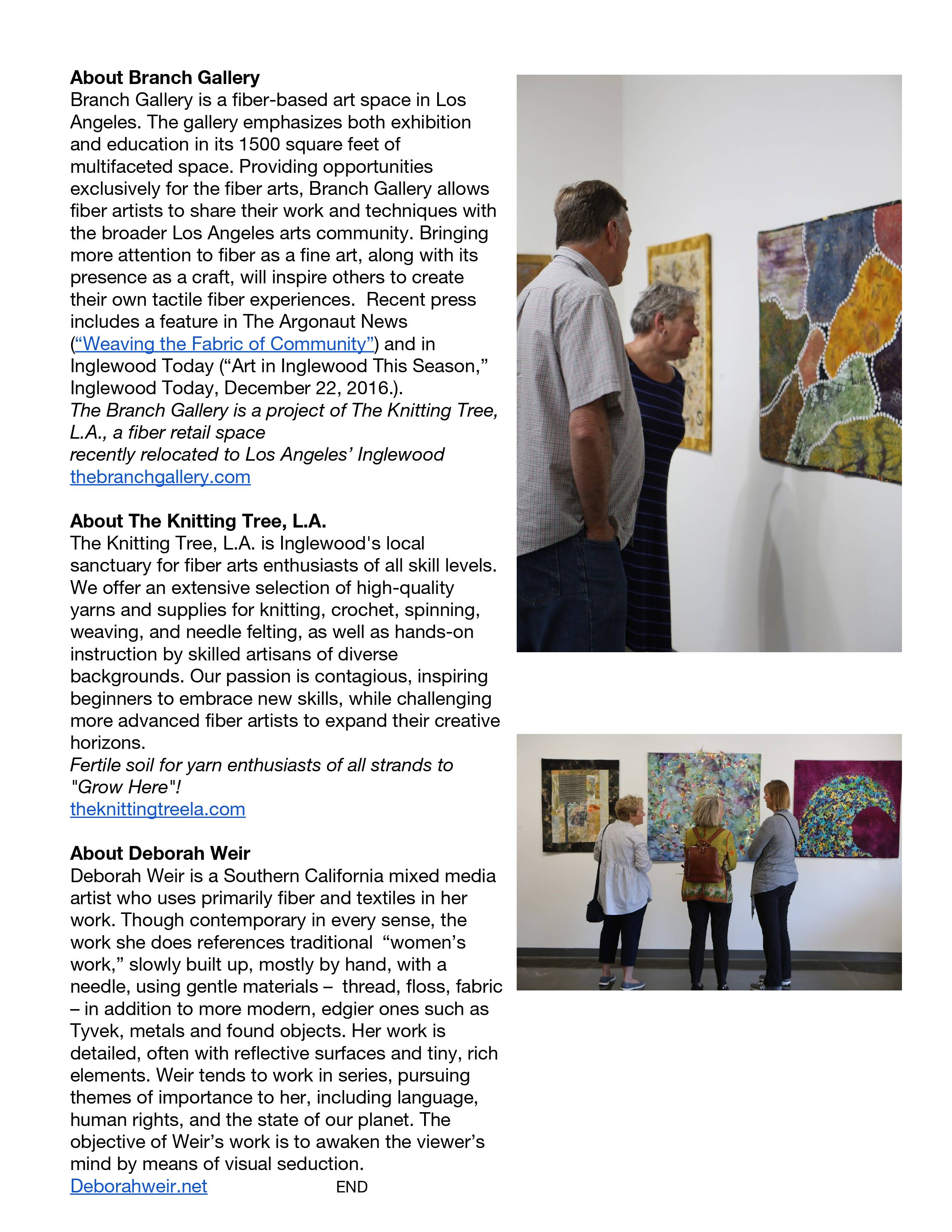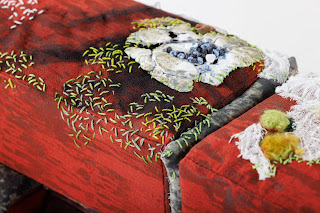Friday, October 27, 2023
Fiber Art Now and Excellence in Quilts by Deborah Weir
My piece Midden #1 is in print in FAN's current edition. And it will be traveling to the Texas Quilt Museum in the summer of 2024. Yes, it's a quilt, but VERY 3 dimensional!
Friday, October 20, 2023
Fall in Philadelphia
It's exciting how Philly loves the Phillies and Eagles, but there's a quiet passion for textiles here too. Haven't made it to the Kanta cloth collection at the PMA yet( through Jan), but I did catch Emily Richardson's amazing show at Gross Mcleaf and Bruce Hoffman's curation of Fiber Art Now's FIBER REIMAGINED at both Gravers Lane Galleries. Both shows run through October. The PMA annual Contemporary Craft show always features interesting Fibers and will run from Nov 3-5. Consider spending some of your fall in Philadelphia!
 |
| Emily Richardson Gross McCleaf Gallery |
 |
| Alicja Kozlowska Gravers Lane Gallery |
Wednesday, October 18, 2023
Breakthrough! by Barbara Matthews
I’ve struggled at releasing myself from the structure that I learned in my prior research career. For example, I have created my own dye color recipes -- 24 bottles of my own dye formulas, carefully documented into ratios of red, blue, yellow, or black that went into each recipe.

It was sort of a mystery to me. I now know my body was telling me this scientific approach was not serving me, that I needed to rely on my intuitive sense of color. I was attempting to document exactness into every project, exactly how I created every color for a particular project—so many drops of yellow mixed with so many drops of blue and then maybe some drops of red added in. Yeah, I’m gagging just writing this.
For the Blurred Boundaries Call I was going after the colors in the Sedona geology. This initial piece captured the colors I wanted. Here I applied thick lines of resist and dye in the spaces in between with a brush in a painterly approach, the dyes running up to the resist line. Sometimes I blended complimentary colors for an ombre effect. However, I wanted something with more texture, plus I needed a variation of values from dark to light.
I put the piece back on a frame to add dye (the frame is
shown below as illustration). I learned a dry dye application method from Karen
Sistek a Master Silk Painter. The dry method is possible by first applying a
starch resist (Magic Sizing) in a spray over the entire piece of silk. After the
starch dries, the dye does not penetrate the silk as quickly. Still, a brush of
dye needs to be almost dry and the dye is applied in small brush strokes.
I loved the effect, not using the dry brush method, but applying wet dye over the starched surface. Dyes did not flow, but resulted in a distressed surface, one that almost looked dirty. Dirty was perfect! I was simulating rocks after all!
I mixed colors on the
fly! No X number of drops of one color or the other! I used the same brush, not
this for olive, this one for purple. It was liberating. The results were
dramatic and interesting! I was mixing methods and mixing dyes with
recklessness and loving the results!
After steaming, this piece is now ready for the final step--more
later.
_________________________________________________________
Silk painting frames I use—PVC pipe, masking tape and pins
to stretch the silk to the frame.
Wednesday, October 11, 2023
Paris Trip
Hi all, We have been in Paris and on the Cote d"Azure for 2 weeks celebrating with an assortment of people my husband's youngest daughter turning 50. One of the things I most wanted to do in Paris was go to the Louvre where I have never been. We got our tickets early and for, what seemed like, a good time. Not. Maybe there are no good times. It was crowded, let me say again, it was crowded. I had a plan that I would not have a plan to see anything specific but to just go with getting a sense of the overall place and kind of coasting around. Not. I ended up in the Greek and Roman statues multiple times no matter where I was headed. I finally saw ( in spite of my best efforts NOT to ) the Mona Lisa. What I actually saw was a very large space filled with people trying to take photos of the Mona Lisa, so I took photos of them photographing the Mona Lisa. I know I can see her on line a lot better then there.
Having made fun of this I did take a lot of photos of the sculptures because I like the faces as they were captured so long ago. One in particular is haunting me. A sculpture of a face under a veil. How do you do that in stone? How do you do that in any medium? So now I think I am going to try that in thread painting - after I think about it for awhile longer.
Tuesday, October 10, 2023
Learning from Failure by Barbara Matthews
I recently had the opportunity to show a piece of work at a night-time illuminated art event-- Luminata at Green Lake in Seattle sponsored by the Fremont Arts Council. My pieces do well in natural light. Glacier Cathedral shown below with natural light coming from behind seemed like the best choice for the event.
I have seen signs made of acrylic effectively illuminated
from below with LED lights. I wanted to try that with this piece.
The vertical pieces of Glacier Cathedral fit into slots cut into a 1” base of acrylic glass. The acrylic base rests on an additional base of steel that is bolted onto the acrylic. With longer bolts and several washers, the acrylic and steel bases could be separated by enough space to accommodate the LED light strips.

I found out days before the event that electricity would not
be made available to the art pieces. So plan B was install a battery pack with
a remote control, both of which I had previously tested. Suddenly the LED lights
went out and the wire was extremely hot. I consulted with friends and my brother
whose ideas were helpful, but did not result in lighted lights. It was then that
I decided I was over my head in my expertise, so
abandoned the idea of LED lights.
Instead I back lit the piece with several battery powered spotlights. A super easy solution. Here the piece at home and at the event.
The failure turned out to be a grand success, but one I could have accomplished in hours rather than days. Perhaps I need to temper my desire to learn new things and rely on others with expertise to handle some parts of the fabrication.
Saturday, October 7, 2023
Creation of Living Bricks: A 3-D Work
On Christmas day 2022 a pipe froze flooding our newly remodeled condominium, leaving us homeless. I was devastated. Yet one week later on New Year’s Day as I walked along Church Street in historic Beaufort, South Carolina I came upon an old brick wall. It was alive with moss, lichen and tiny ferns, one brick so different from the next. I decided to make a fabric brick wall. I discovered some wooden jewelry/treasure boxes on line that were the size of bricks. I then covered the boxes in batting and hand dyed and painted fabrics. Embellishing each brick was fun using nylon netting, Tyvek, wool roving, cheesecloth with lots of stitching with embroidery floss. I then played with arranging the bricks to form the wall.
Visit Barbara's website












 Mona Lisa
Mona Lisa


























